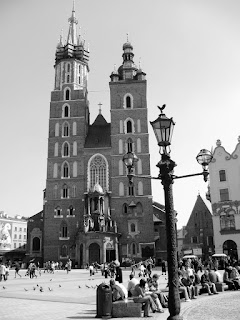Cracow: Florence of the North
I've been in Cracow for about a day, and it's taken me a while to find my bearings (not that I've actually found them yet). The thing that's most striking to me are the similarities with Florence. It was only after realizing this that I vaguely remembered having heard Cracow referred to as the 'Florence of the North.' Thanks to Google, I was able to confirm my suspicion. As one Web site says:
Though sometimes called the Florence of the North, or Polish Rome, Cracow shall always be Cracow, no matter what comparisons are made about its similarities to other places.
I've been honing my observational skills by trying to identify buildings by their architectural styles. Are they Gothic, Classical, Mannerist, Baroque, Neo-Classical, or transitional with elements of more than one style?
Whole blocks of streets in and around the Old Quarter have a Florentine character. And like Florence's central square, Cracow's central Market Square is a remnant from medieval times, with numerous churches of many styles and periods. However, I do sense a distinct Polish style which is most apparent in the older Gothic buildings which look like they might carry a Dutch influence. Churches are crowned with multiple mini-spires (a good example is the Church of St. Mary's), and other buildings are topped with multiple crenellations or other decorative elements. There are lots of little niches with statues and sculptural busts, or portrait medallions carved in relief.
It's a more-is-better mentality that recalls the Buddhist belief that the ultimate act of devotion is in the creation of his image. The more Buddhas created, the more devout the creator and the more of that devotion will be transferred to the observer in the contemplation of multiple images. So this is the Roman Catholic version of that idea. Anyway, I'm just going by instinct here, so I could be completely off base. The pictures below are from the Old Quarter.
 Great music! Notice the picture on the left-hand side of the photo
Great music! Notice the picture on the left-hand side of the photo
in which these two are meeting Pope John Paul II.
 A view of the central Market Square with the Church of St. Mary's.
A view of the central Market Square with the Church of St. Mary's.
 Another view of the Church of St. Mary's.
Another view of the Church of St. Mary's.


 A remnant of the medieval city wall with its towers.
A remnant of the medieval city wall with its towers.
Notice the platform for archers. The picture below is another view.
Though sometimes called the Florence of the North, or Polish Rome, Cracow shall always be Cracow, no matter what comparisons are made about its similarities to other places.
I've been honing my observational skills by trying to identify buildings by their architectural styles. Are they Gothic, Classical, Mannerist, Baroque, Neo-Classical, or transitional with elements of more than one style?
Whole blocks of streets in and around the Old Quarter have a Florentine character. And like Florence's central square, Cracow's central Market Square is a remnant from medieval times, with numerous churches of many styles and periods. However, I do sense a distinct Polish style which is most apparent in the older Gothic buildings which look like they might carry a Dutch influence. Churches are crowned with multiple mini-spires (a good example is the Church of St. Mary's), and other buildings are topped with multiple crenellations or other decorative elements. There are lots of little niches with statues and sculptural busts, or portrait medallions carved in relief.
It's a more-is-better mentality that recalls the Buddhist belief that the ultimate act of devotion is in the creation of his image. The more Buddhas created, the more devout the creator and the more of that devotion will be transferred to the observer in the contemplation of multiple images. So this is the Roman Catholic version of that idea. Anyway, I'm just going by instinct here, so I could be completely off base. The pictures below are from the Old Quarter.
(Click the images to enlarge)
 Great music! Notice the picture on the left-hand side of the photo
Great music! Notice the picture on the left-hand side of the photoin which these two are meeting Pope John Paul II.
 A view of the central Market Square with the Church of St. Mary's.
A view of the central Market Square with the Church of St. Mary's. Another view of the Church of St. Mary's.
Another view of the Church of St. Mary's.

 A remnant of the medieval city wall with its towers.
A remnant of the medieval city wall with its towers.Notice the platform for archers. The picture below is another view.
Labels: Baroque, Classical, Cracow, Florence, Gothic, Krakow, Mannerist, Neo-Classical, Poland






































